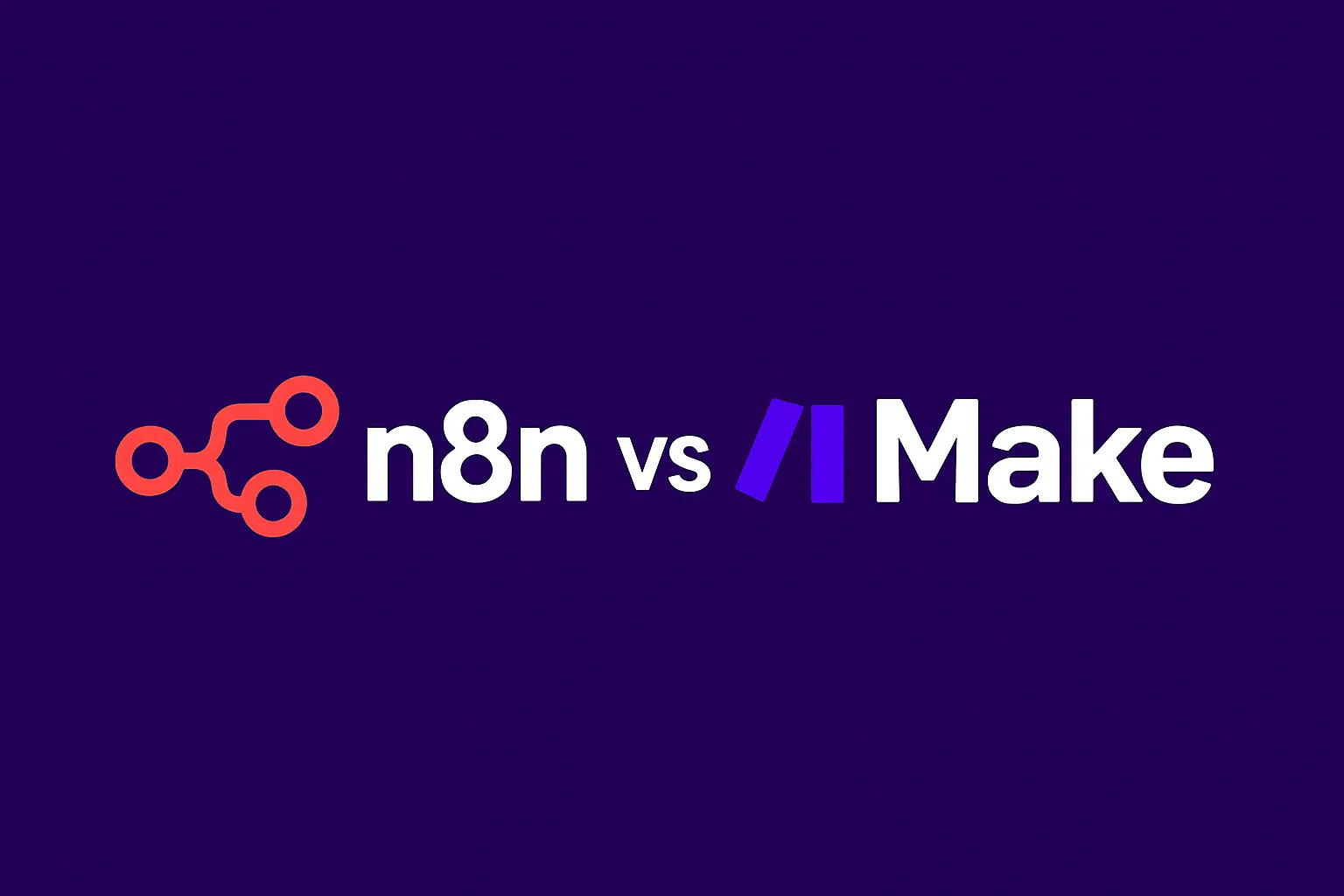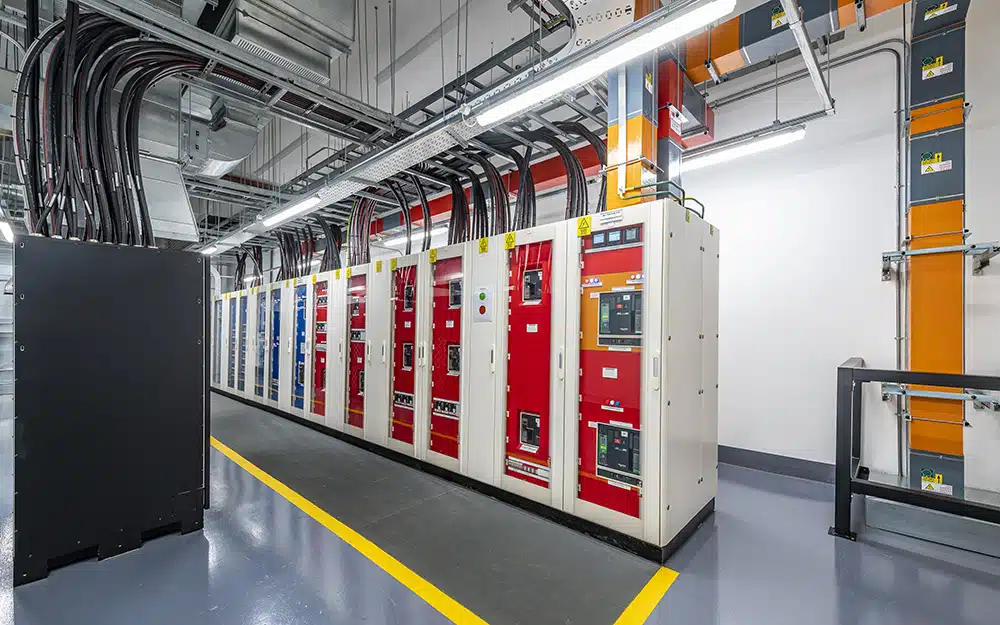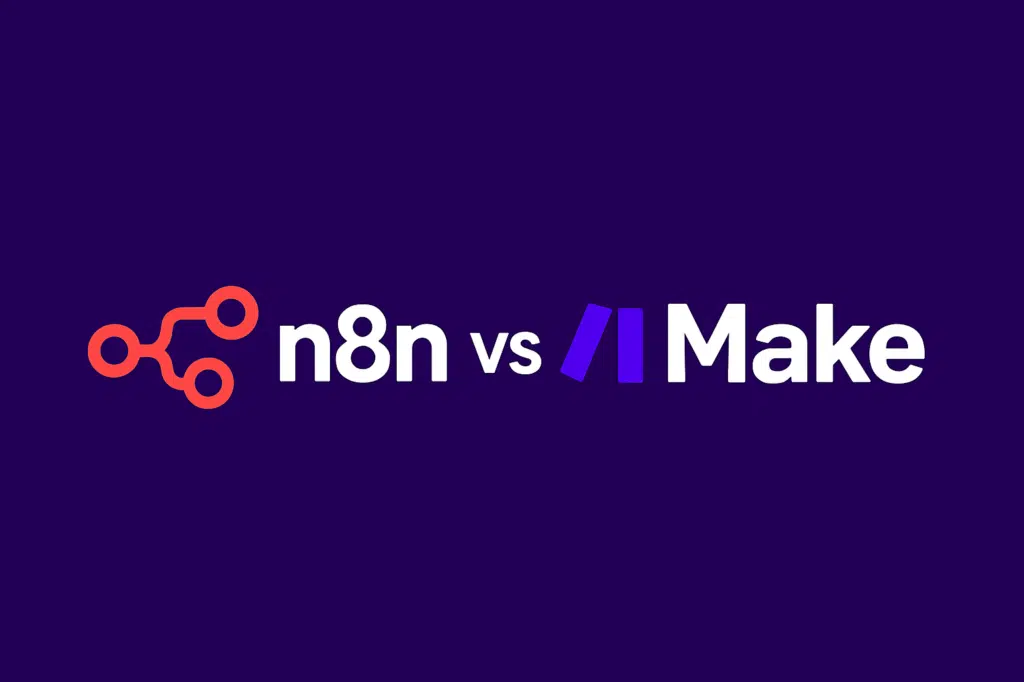
The idea of automation plays as fast in the head as it’s designed to happen in real life.
Right now, everyone craves a little of that fastness and ease, especially in workspaces, since this aspect, more than personal living, can actually be automated from A to Z.
In 2025, n8n and Make have established themselves as worthy choices for anyone looking to give automation several chances.
But there’s a difference between making a name and actually living up to the reputation. I locked into n8n and Make, turned YouTube tutorial videos into Netflix thrills, made Reddit reviews and articles a priority, and finally signed up for these two for a test. This review is my own contribution to this much-asked question: n8n vs. Make, which is a better automator in 2025?
Let’s see what I found out below.
Key takeaways from this article
- On Hosting, n8n lets you either self-host or use their cloud service, giving you full control over your data and setup. That’s great if you care about security or compliance. Make, on the other hand, is cloud-only, so you don’t get to host it yourself — everything runs on their servers.
- For the User Interface, n8n’s editor is feature-packed and lets you add custom code, but it can feel a bit complex if you’re new to this. Make’s drag-and-drop builder is way simpler and more beginner-friendly, making it easier to start without coding.
- In AI Integration, you can chain multiple AI nodes, use custom models, and even build multi-agent workflows for complex automations with n8n. Make offers plug-and-play AI modules that are quick to use but don’t give you as much flexibility.
- On app Integrations, Make has a vast library (over 1,500 prebuilt integrations), so connecting popular apps is super easy. n8n has fewer out of the box, let’s say 400+, but is impressive when you want to connect to custom APIs.
- For workflow complexity, n8n supports complex workflows with branching, looping, and custom code, which is perfect if you want detailed control. Make handles multi-step scenarios well, but it isn’t as flexible for really advanced logic.
- On pricing, n8n charges per workflow execution and even offers a free self-hosted option, which can save you money if you run heavy or complex automations. Make charges per operation, so costs can add up fast if your workflows have many steps or run often.
- On Security, if you self-host n8n, you get complete control over your data and security settings, plus enterprise features like role-based access control. Make relies on their cloud security, which is solid, but means less control over where your data lives.
- Community-wise, n8n benefits from an active open-source community that keeps adding new features and integrations. Make has a big user base and offers official support and lots of documentation to help you out.
Why I compared n8n and Make
When I decided to get into AI automation platforms, I chose to compare n8n and Make because both have become well-known for their visual workflow builders, strong AI integration features, and broad app connectivity. From my initial research, I realized that while they share some similarities, they differ quite a bit in their flexibility, hosting options, and the depth of AI capabilities they offer.
I felt it was essential to understand these differences firsthand to determine which platform would best suit my AI automation needs. This comparison helped me (and will help you) make a more informed decision based on real-world use rather than just marketing claims.
What’s n8n?
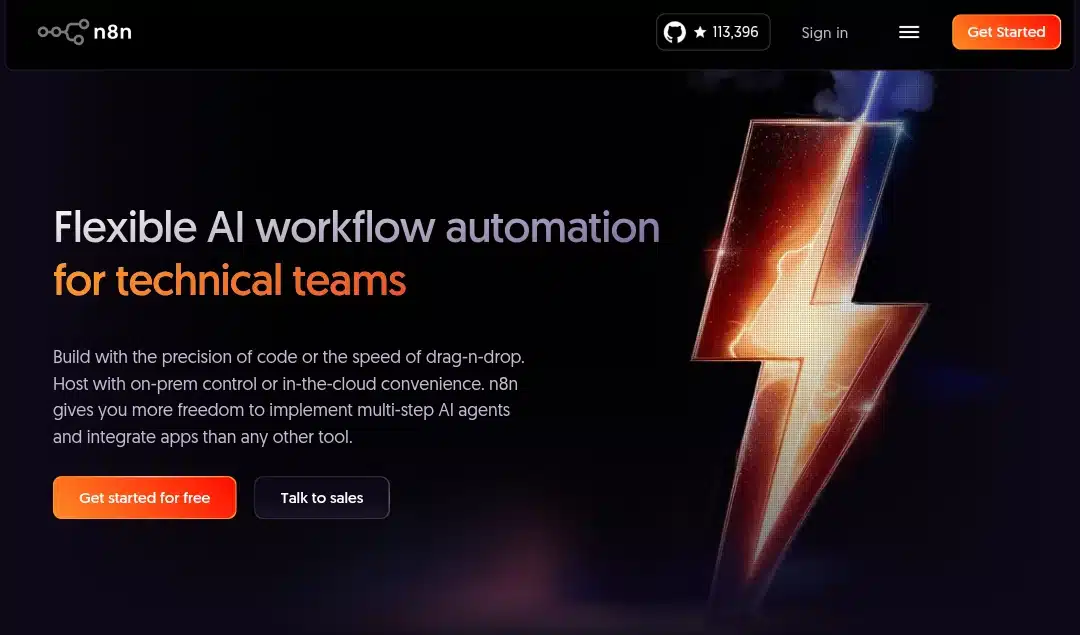
n8n is an open-source workflow automation tool that allows users to visually create and automate workflows by connecting various apps, services, and APIs without extensive coding knowledge. It uses a node-based approach where each node represents an action or integration, enabling users to build complex, multi-step workflows with triggers and actions.
n8n supports custom JavaScript or Python code for advanced customization, offers over 1,700 templates, and can be self-hosted or used as a cloud service. It emphasizes flexibility, developer-friendly features like branching and merging workflows, and integrates AI capabilities for tasks such as content generation.
What’s Make?
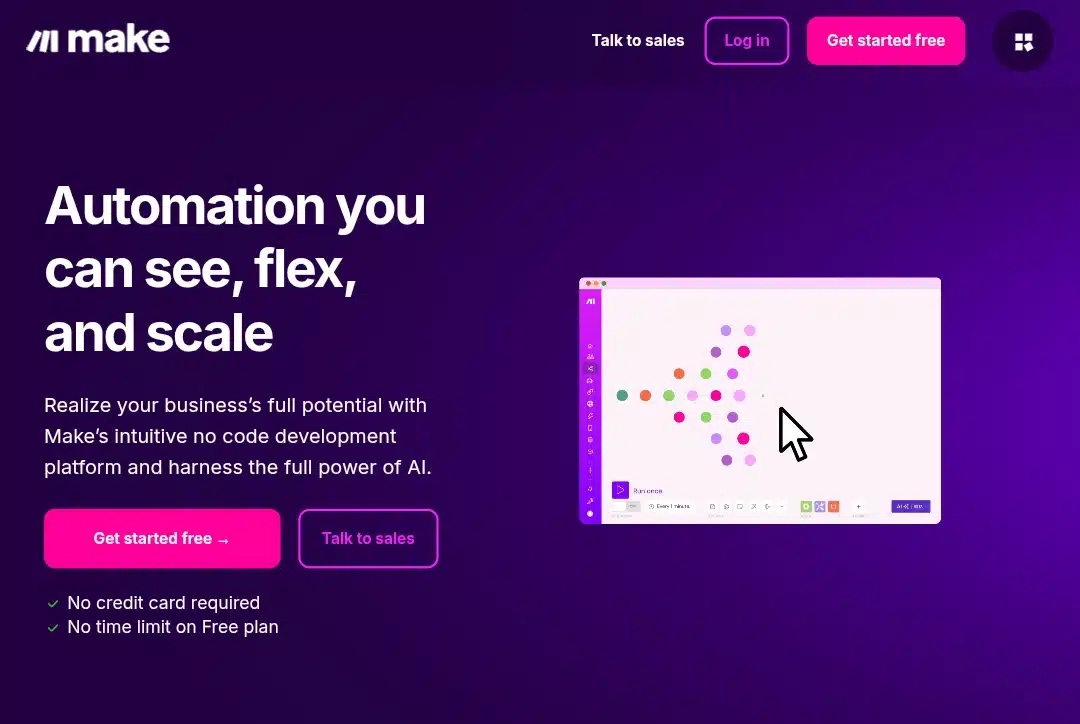
Make (formerly known as Integromat) is a cloud-based workflow automation platform that also provides a visual drag-and-drop interface to connect apps and automate tasks. It is designed to be easy to use for non-developers, offering a wide range of built-in integrations and functions out of the box. Make focuses on simplicity and robustness, managing all infrastructure in the cloud, so users do not need to worry about hosting or coding. It provides extensive native connections and is often considered more accessible for users without technical backgrounds compared to n8n
A quick look at n8n vs Make features
| Aspect | n8n | Make (formerly Integromat) |
| Open Source | Fully open source, allowing self-hosting and extensive customization of the platform. This provides maximum control over data, security, and workflow behavior. | Proprietary SaaS platform with no self-hosting option. Users rely entirely on Make’s cloud infrastructure. |
| Hosting Options | Flexible: self-host on-premises, private cloud, or use n8n cloud service. Ideal for organizations with strict compliance or data sovereignty needs. | Cloud-only, managed by Make. No option for self-hosting, which may be a limitation for sensitive data environments. |
| User Interface | Visual drag-and-drop editor with advanced features like code nodes for JavaScript and Python. Steeper learning curve, but highly flexible. | Intuitive drag-and-drop scenario builder focused on ease of use. Great for non-technical users, but less flexible for custom coding. |
| AI Integration | Deep AI integration with support for chaining multiple AI nodes, custom AI models, and multi-agent workflows. Allows complex AI orchestration. | AI agents and modules are plug-and-play, enabling quick AI-powered automation but with limited customization and chaining capabilities. |
| App Integrations | There are over 400 integrations, with strong support for custom API connections via HTTP nodes. The community actively contributes new connectors. | Extensive library of 1,500+ integrations, covering a wider range of popular SaaS applications out of the box. |
| Customization | High customization via code nodes, environment variables, and open APIs. Suitable for developers and technical teams. | Customization is mostly through prebuilt modules and HTTP requests. It is less suited for deep scripting or complex logic. |
| Pricing Model | Free for self-hosting; cloud plans start at $20/month. Cost-effective for scaling with technical expertise. | Usage-based pricing is tied to operations and data volume. A free tier is available, but it can become costly at scale. |
| Security & Compliance | Strong security controls in self-hosted deployments, including RBAC, audit logs, and compliance certifications for the cloud. | Standard SaaS security measures; compliance depends on Make’s cloud environment. Limited control over data residency. |
| Workflow Complexity | Supports complex branching, looping, and multi-agent AI workflows with robust debugging tools. | It supports multi-step scenarios with conditional logic but is limited to highly complex AI orchestration. |
| Community & Support | Active open-source community with forums, Discord, and frequent updates. | Large user base with official support channels and extensive documentation. |
Now, let’s get to know how these features came to behave in task situations.
My user experience with n8n and Make (First impressions)
When I initiated my testing of n8n and Make, I wanted to understand how accessible and practical each platform was for building AI automations. Both platforms offer visual workflow builders, but their approaches to setup and usability differ quite a bit.
n8n: Flexible setup with some technical requirements
With n8n, I had the option to self-host on my own server, use Docker, or opt for their managed cloud service. I chose to self-host because I wanted control over my data and environment. Setting up n8n required some familiarity with server management and Docker, so it wasn’t entirely straightforward for someone without a technical background. However, the documentation was clear and helped me through the process.
Once I accessed the workflow editor, I found it straightforward to use. The drag-and-drop interface allowed me to connect nodes easily, and features like branching and looping were simple to implement. The editor also provides inline logs, which helped me see what happened at each step, making troubleshooting easier.
While the platform has many advanced features, I noticed that beginners might need some time to get comfortable with things like custom code nodes or multi-agent workflows. Still, the visual nature of the editor and the active community support made learning manageable. I also appreciated being able to add JavaScript or Python code directly into workflows, which gave me more control over automation logic.
Make: quick start with cloud convenience
Make is a cloud-based platform, so I didn’t have to worry about installation or hosting. After signing up, I was asked about my workflow automation expertise, before I could immediately start building automations, and I chose the first option, just to get a first-timer feel of the tool.
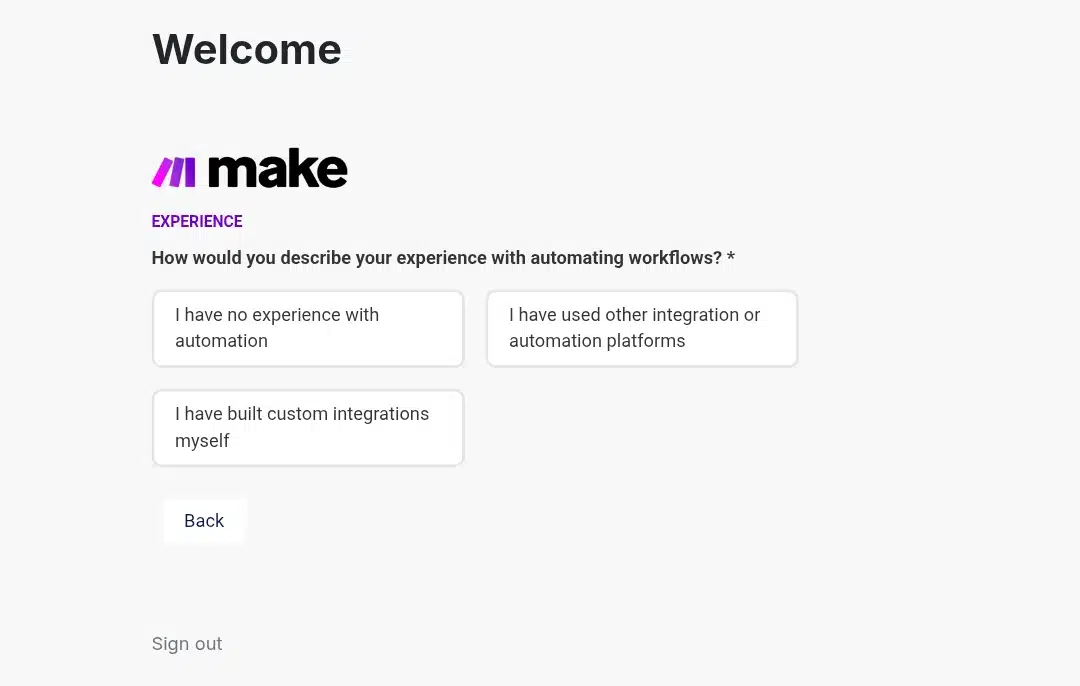
This made it easy to get going, especially if you want to avoid a technical setup.
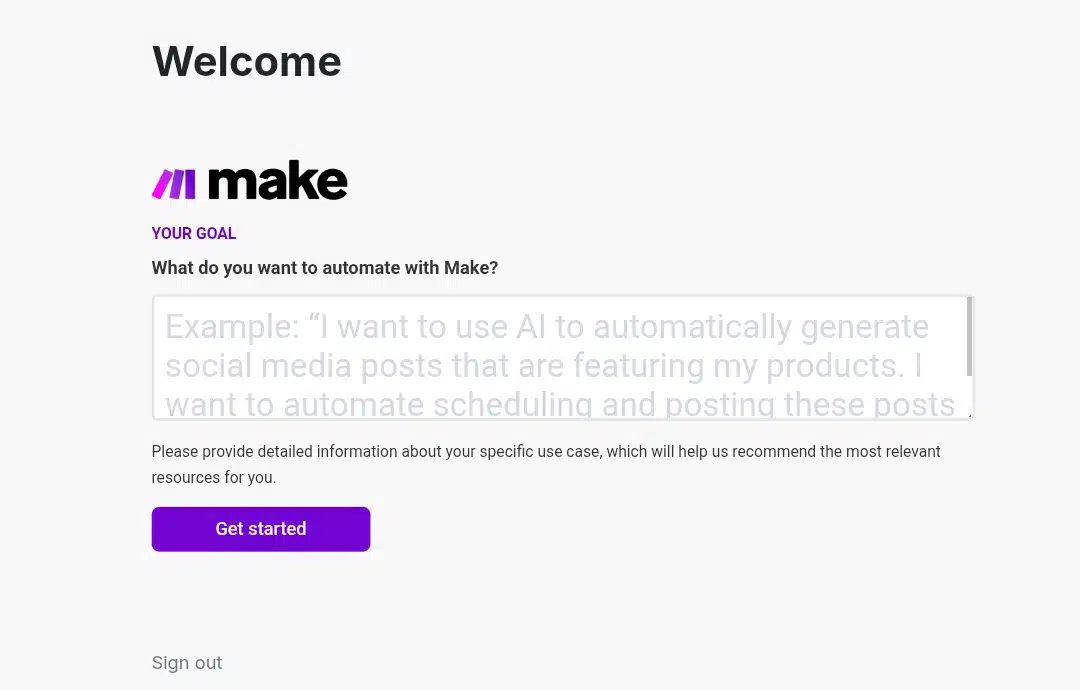
The scenario builder is also drag-and-drop, but focuses on connecting prebuilt modules. I found it user-friendly, especially for simple to medium complexity workflows. Setting up integrations with popular apps was quick, and I didn’t need to write any code for most tasks.
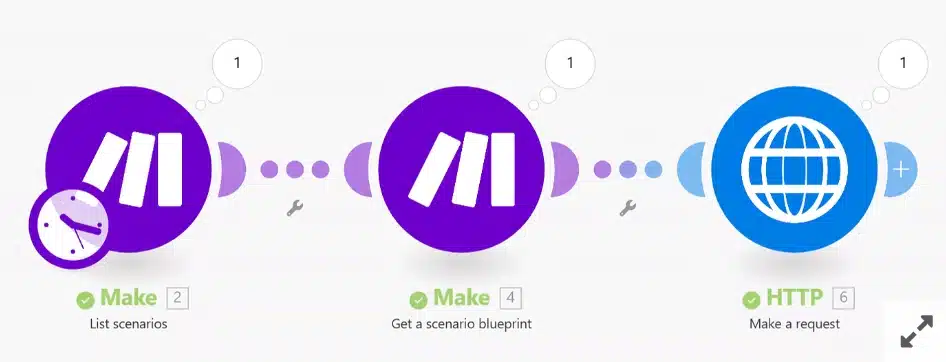
However, I found the platform less flexible when I tried to build more complex workflows or customize AI models. Make supports HTTP modules for custom API calls, but doesn’t offer the same depth of scripting or multi-agent AI capabilities as n8n. For many everyday use cases, though, it works well.
AI Integration: Depth and flexibility
n8n: Customizable AI workflows
n8n includes built-in AI nodes for tasks like text summarization, question answering, chat interactions, and content generation. What stood out to me was the ability to integrate custom AI models from providers like OpenAI, Google AI, or even my own models.
I was able to chain multiple AI nodes together, combining AI outputs with business logic to create more nuanced workflows. For example, I built an automation in which AI analyzed input data, generated responses, and then routed results based on confidence levels. The platform also supports multi-agent workflows, where several AI agents can work together or escalate tasks as needed.
Testing and debugging AI workflows was straightforward thanks to features like data replay, inline logs, and visual workflow mapping. These tools helped me identify issues and refine my automations.
Make: Easy-to-use AI agents
Make offers AI Agents that let you add AI-powered steps like summarization, data enrichment, and decision-making with minimal setup. The AI modules are plug-and-play, which makes it easy to incorporate AI into your workflows without much technical effort.
I liked that the scenarios could adapt based on AI outputs in real time, allowing for dynamic automation. It also efficiently moves AI-generated data to other apps like CRMs, Slack, or databases.
That said, Make’s AI customization options are more limited. You primarily work within the predefined AI modules, so building complex multi-agent workflows or chaining AI models is not as flexible as with n8n.
Integrations: Number vs. Customization
Make has an extensive library of over 1,500 prebuilt integrations covering many SaaS apps, AI agents, databases, and cloud services. This makes connecting AI workflows to popular tools quick and easy.
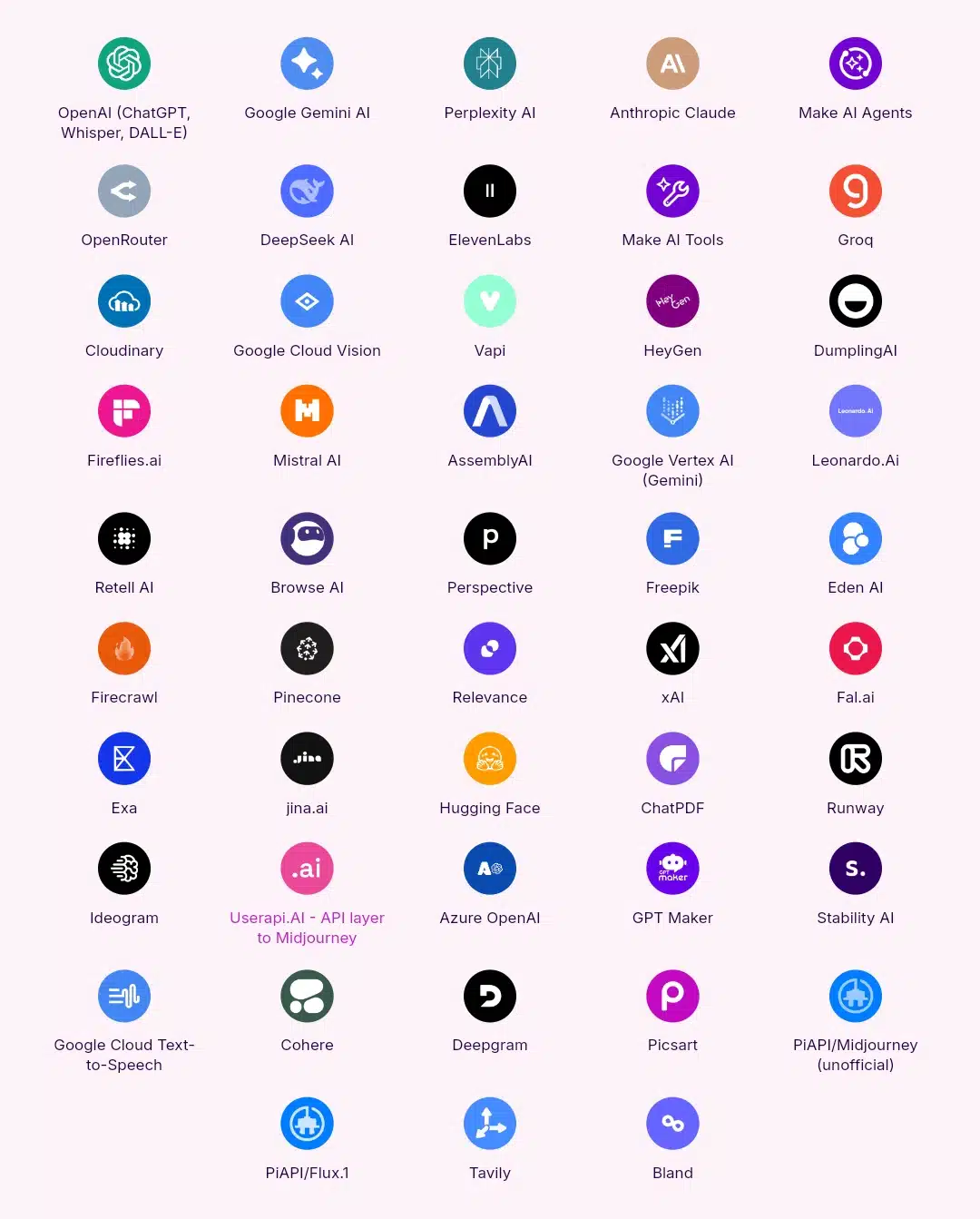
n8n has fewer prebuilt integrations, around 400 and growing, but it offers strong customization through its HTTP Request node. This means I could connect to virtually any REST API, allowing for custom integrations beyond the standard list. The open-source community also regularly contributes new connectors.
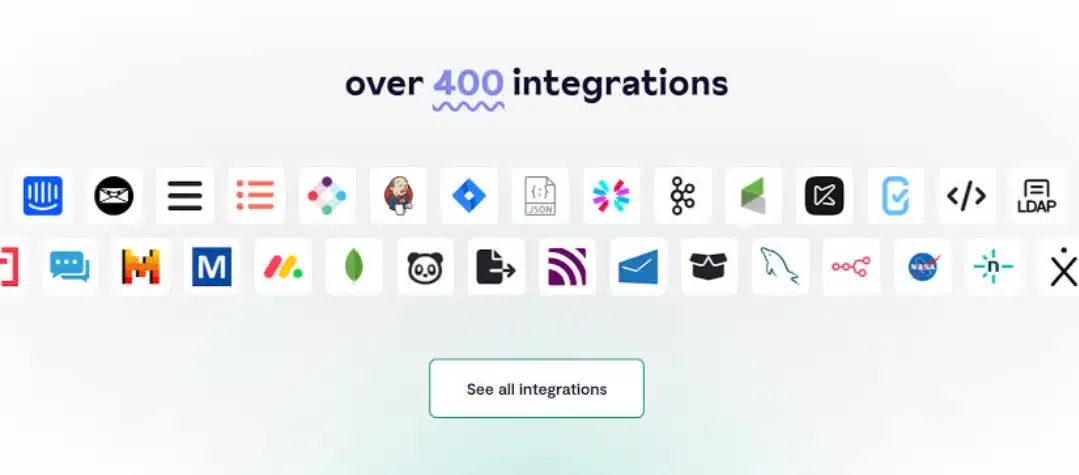
Workflow complexity: How far can you go with n8n and Make?
With n8n, I was able to create workflows that included branching, looping, and multi-agent AI orchestration. I could insert custom code blocks for advanced processing, error handling, and triggers. The platform also lets you visualize each step, replay data, and monitor execution in real time, which helped me troubleshoot effectively.
Make supports multi-step scenarios with conditional logic and data mapping. Its AI agents can adjust workflows based on changing data or outputs. However, deep customization, such as multi-agent systems or complex AI chaining, was harder to implement. I was limited by the available modules and scenario logic.
Security and compliance: Control and convenience
Security was an important consideration for me. n8n’s security advantages come primarily from its self-hosting option, which gives users complete control over data and infrastructure. This is crucial for organizations with sensitive workflows or strict regulatory requirements. n8n also offers enterprise-grade features such as role-based access control (RBAC), single sign-on (SSO), audit logs, and secure secret management. Their cloud service is SOC 2 compliant, providing a secure managed option but with less control than self-hosting.
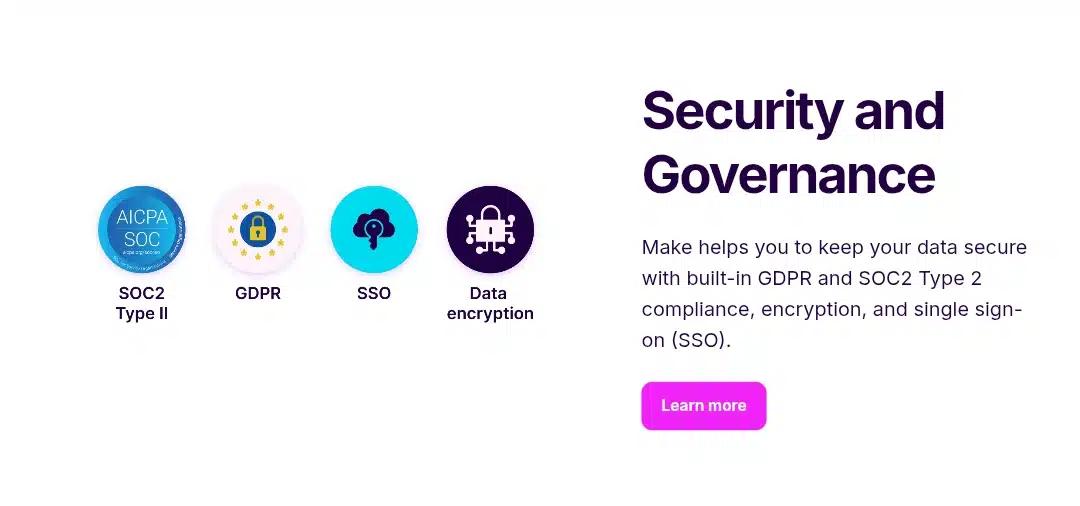
Make.com, by contrast, is a cloud-only SaaS platform that processes data on its servers. It provides standard SaaS security features, including GDPR compliance, SOC 2 Type 2 compliance, data encryption, and company-wide SSO. However, since Make does not offer self-hosting, users have less control over data residency and infrastructure, which can be a limitation for organizations with stringent compliance or data sovereignty needs. Make’s enterprise plans include enhanced security features, 24/7 premium support, and SLA guarantees, making it a robust option for many businesses, but still less flexible than n8n’s self-hosted model.
n8n vs Make: Pros and Cons
n8n Pros:
- Open-source and supports self-hosting, giving you complete control over your data and infrastructure.
- Highly flexible and developer-friendly, allowing custom JavaScript/Python code within workflows.
- Advanced workflow capabilities like multi-branching, looping, and multi-agent AI orchestration.
- Pricing based on workflows rather than operations, often more cost-effective at scale.
- Strong security and compliance features, including role-based access control and audit logs.
- Active community and growing integration library with the ability to connect to any REST API.
- Excellent debugging tools like inline logs, data replay, and visual workflow mapping.
- Deep AI integration, including chaining multiple AI steps and custom AI models.
n8n Cons:
- Steeper learning curve, especially for non-technical users.
- Setup can be complex if self-hosting, requiring some DevOps knowledge.
- Smaller number of prebuilt integrations compared to Make.
- Documentation can be less accessible for beginners.
Make Pros:
- Cloud-based with no installation or hosting required, easy to get started quickly.
- Intuitive drag-and-drop interface designed for no-code and low-code users.
- An extensive library of over 1,500 prebuilt app integrations for quick connections.
- Suitable for simple to moderately complex workflows with conditional logic and scheduling.
- Plug-and-play AI agents for summarization, enrichment, and decision-making.
- Substantial data transformation and routing capabilities.
- Robust error handling and debugging tools.
- Competitive pricing for low-volume usage and straightforward automations.
Make Cons:
- No self-hosting option, data is processed on Make’s cloud servers, which may concern regulated industries.
- Less flexible for deep customization or complex AI chaining compared to n8n.
- Pricing can escalate quickly with high operation volumes.
- Limited ability to insert custom code or build multi-agent AI workflows.
- Some advanced features are reserved for higher-tier plans.
Now that we’ve sorted out their areas of strength and weakness, let’s see how much it costs to get access to n8n and Make.
Pricing comparison: n8n vs Make
When I looked into pricing for n8n and Make, I quickly realized they have very different billing approaches, which can affect costs depending on how they are used.
For n8n, pricing is based on workflow executions. That means every time I run a workflow from start to finish, it counts as one execution, no matter how many steps it contains. On the other hand, Make charges based on operations—each individual step or module in a workflow counts as one operation. So, if my workflow has many steps, the number of operations adds up fast.
Here’s what I found about their pricing plans:
n8n pricing
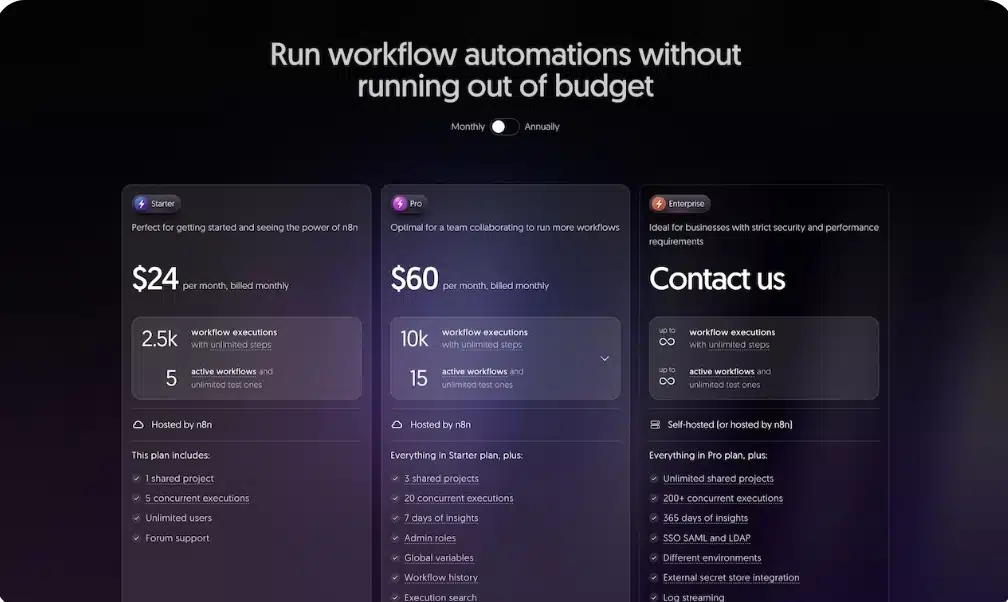
If I choose to self-host n8n, it’s completely free. My only cost is the server or cloud service I use to run it, which can be as low as $5 to $10 per month, depending on the provider.
Their cloud plans start at around $24 per month for 2,500 workflow executions and up to 5 active workflows. One nice thing about this plan is that I can have unlimited users.
If I need more executions or active workflows, higher plans are available, like the Pro plan, which costs $60 monthly for 10,000 executions.
What I really like about n8n’s pricing is that it charges per workflow execution, so if my workflow processes a large batch of data in one go, it only counts as one execution. That can save a lot if I’m dealing with data-heavy automations.
Make pricing
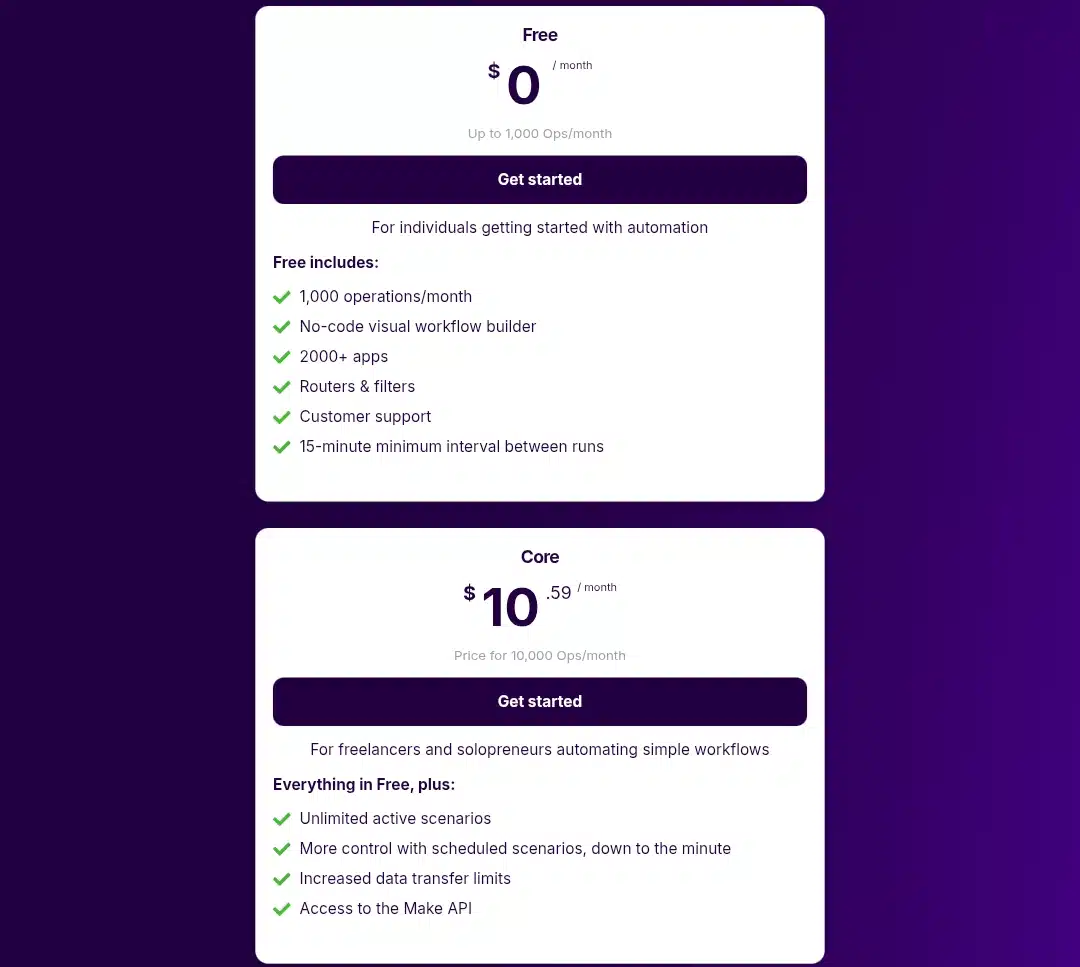
Make offers a free tier with 1,000 monthly operations, which is suitable for very light use.
Their paid plans start at about $10.59 monthly for 10,000 operations and allow unlimited active scenarios and users.
Since Make charges per operation, workflows with many steps or that run frequently can get expensive quickly.
Make’s pricing can be more affordable for workflows with fewer steps but frequent runs.
How do these prices work in practice
Let’s say I have a workflow with 5 steps, and I want to run it 2,500 times a month:
With n8n, that counts as 2,500 workflow executions, which fits within their Starter plan.
With Make, it counts as 12,500 operations (5 steps × 2,500 runs), which is more than the 10,000 operations included in their Core plan, so I’d likely face extra charges.
n8n vs Make pricing summary
| Feature | n8n Starter Plan | Make Core Plan |
| Starting Price | ~$24/month (€22) | ~$10.59/month |
| Workflow Executions / Operations | 2,500 workflow executions | 10,000 operations |
| Active Workflows / Scenarios | 5 active workflows | Unlimited active scenarios |
| Users | Unlimited | Unlimited |
| Integrations | 400+ | 1,500+ |
| Execution Logs | 7 days | 7 days |
| Self-Hosting Option | Yes (free) | No |
Who should use n8n?
Here are the classes of people that fit:
Developers and technically skilled users. n8n offers deep customization with native support for JavaScript functions, custom API calls, and coding within workflows.
Organizations need complex, multi-step workflows. It supports advanced logic like branching, loops, merges, and wait steps, which is ideal for operationally intensive automations.
Users or businesses wanting complete control over data and infrastructure. n8n can be self-hosted, making it perfect for those with security, compliance, or data residency requirements.
Cost-conscious users with complex workflows. Since n8n charges per workflow execution (not per step), it is more cost-effective for workflows with many steps or data actions.
Those pushing the boundaries with AI. n8n leads with advanced AI agents and Retrieval Augmented Generation (RAG) capabilities, suitable for cutting-edge automation.
Who should use Make?
These groups will get the best of Make:
Non-technical users and beginners. Make’s drag-and-drop, no-code interface is intuitive and easy to learn, making it great for quick setup and deployment without coding.
Businesses that want a polished, professional SaaS solution should consider Make. It is a cloud-only platform with robust, business-ready features and enterprise support.
Users with more straightforward or moderately complex workflows. Make supports multiple paths and filters, but is optimized for workflows with fewer steps or more straightforward logic.
Those who want an extensive library of prebuilt integrations. Make offers 2,000+ native apps with seamless setup, which is ideal for popular SaaS stacks.
Users who prefer operation-based pricing for frequent but simple workflows. Make charges per operation (step), which can be cheaper for workflows with fewer steps but frequent runs.
Users who value workflow organization and team collaboration. Make allows unlimited folders and team roles, helping users easily manage multiple projects.
Final verdict: n8n vs Make, which one is better?
Both n8n and Make are strong automation platforms, but the best choice depends on what you need. If you prefer having complete control over your data and want to build highly customizable workflows with the option to add your own code, n8n is a good fit. It’s especially suitable if you’re comfortable with some technical setup or want to self-host for security reasons. n8n also supports complex AI workflows and multi-agent systems, which can be valuable for advanced automation.
On the other hand, Make might be better if you’re looking for a cloud-based platform that requires no installation and offers an extensive library of ready-to-use integrations. It’s user-friendly and great for quickly setting up straightforward automations, especially if you don’t want to write code or manage infrastructure.
When choosing between the two, consider your technical skills, security needs, and the complexity of your AI workflows. Both platforms can deliver great results when matched to the right use case.

